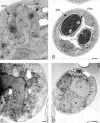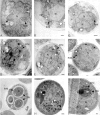Prospore membrane formation defines a developmentally regulated branch of the secretory pathway in yeast
- PMID: 9425151
- PMCID: PMC2132592
- DOI: 10.1083/jcb.140.1.29
Prospore membrane formation defines a developmentally regulated branch of the secretory pathway in yeast
Abstract
Spore formation in yeast is an unusual form of cell division in which the daughter cells are formed within the mother cell cytoplasm. This division requires the de novo synthesis of a membrane compartment, termed the prospore membrane, which engulfs the daughter nuclei. The effect of mutations in late-acting genes on sporulation was investigated. Mutation of SEC1, SEC4, or SEC8 blocked spore formation, and electron microscopic analysis of the sec4-8 mutant indicated that this inability to produce spores was caused by a failure to form the prospore membrane. The soluble NSF attachment protein 25 (SNAP-25) homologue SEC9, by contrast, was not required for sporulation. The absence of a requirement for SEC9 was shown to be due to the sporulation-specific induction of a second, previously undescribed, SNAP-25 homologue, termed SPO20. These results define a developmentally regulated branch of the secretory pathway and suggest that spore morphogenesis in yeast proceeds by the targeting and fusion of secretory vesicles to form new plasma membranes in the interior of the mother cell. Consistent with this model, the extracellular proteins Gas1p and Cts1p were localized to an internal compartment in sporulating cells. Spore formation in yeast may be a useful model for understanding secretion-driven cell division events in a variety of plant and animal systems.
Figures







Similar articles
-
Identification of domains required for developmentally regulated SNARE function in Saccharomyces cerevisiae.Genetics. 2000 Aug;155(4):1643-55. doi: 10.1093/genetics/155.4.1643. Genetics. 2000. PMID: 10924463 Free PMC article.
-
Activation of Rab GTPase Sec4 by its GEF Sec2 is required for prospore membrane formation during sporulation in yeast Saccharomyces cerevisiae.FEMS Yeast Res. 2018 Feb 1;18(1). doi: 10.1093/femsyr/fox095. FEMS Yeast Res. 2018. PMID: 29293994
-
Sec9 is a SNAP-25-like component of a yeast SNARE complex that may be the effector of Sec4 function in exocytosis.Cell. 1994 Oct 21;79(2):245-58. doi: 10.1016/0092-8674(94)90194-5. Cell. 1994. PMID: 7954793
-
Clues to brain function from bakers' yeast.Proc Natl Acad Sci U S A. 1994 Mar 15;91(6):1987-8. doi: 10.1073/pnas.91.6.1987. Proc Natl Acad Sci U S A. 1994. PMID: 8134336 Free PMC article. Review. No abstract available.
-
Sporulation in the budding yeast Saccharomyces cerevisiae.Genetics. 2011 Nov;189(3):737-65. doi: 10.1534/genetics.111.127126. Genetics. 2011. PMID: 22084423 Free PMC article. Review.
Cited by
-
The syntaxin 31-induced gene, LESION SIMULATING DISEASE1 (LSD1), functions in Glycine max defense to the root parasite Heterodera glycines.Plant Signal Behav. 2015;10(1):e977737. doi: 10.4161/15592324.2014.977737. Plant Signal Behav. 2015. PMID: 25530246 Free PMC article.
-
Identification of domains required for developmentally regulated SNARE function in Saccharomyces cerevisiae.Genetics. 2000 Aug;155(4):1643-55. doi: 10.1093/genetics/155.4.1643. Genetics. 2000. PMID: 10924463 Free PMC article.
-
Nud1p, the yeast homolog of Centriolin, regulates spindle pole body inheritance in meiosis.EMBO J. 2006 Aug 23;25(16):3856-68. doi: 10.1038/sj.emboj.7601254. Epub 2006 Aug 3. EMBO J. 2006. PMID: 16888627 Free PMC article.
-
Roles of septins in prospore membrane morphogenesis and spore wall assembly in Saccharomyces cerevisiae.Mol Biol Cell. 2016 Feb 1;27(3):442-50. doi: 10.1091/mbc.E15-10-0721. Epub 2015 Dec 17. Mol Biol Cell. 2016. PMID: 26680739 Free PMC article.
-
Human initiator caspases trigger apoptotic and autophagic phenotypes in Saccharomyces cerevisiae.Biochim Biophys Acta. 2009 Mar;1793(3):561-71. doi: 10.1016/j.bbamcr.2008.12.016. Epub 2009 Jan 2. Biochim Biophys Acta. 2009. PMID: 19166881 Free PMC article.
References
-
- Angold RE. The formation of the generative cell in the pollen grain of Emdmyion non-scriptus(L) J Cell Sci. 1968;3:573–578. - PubMed
-
- Brennwald P, Kearns B, Champion K, Keranen S, Bankaitis V, Novick P. Sec9 is a SNAP-25-like component of a yeast SNARE complex that may be the effector of Sec4 function in exocytosis. Cell. 1994;79:245–258. - PubMed
-
- Briza P, Breitenbach M, Ellinger A, Segall J. Isolation of two developmentally regulated genes involved in spore wall maturation in Saccharomyces cerevisiae. . Genes Dev. 1990;4:1775–1789. - PubMed
-
- Byers, B. 1981. Cytology of the yeast life cycle. In The Molecular Biology of the Yeast Saccharomyces: Life Cycle and Inheritance. J.N. Strathern, E.W. Jones, and J.R. Broach, editors. Cold Spring Harbor Laboratory, Cold Spring Harbor, NY. 59–96.
Publication types
MeSH terms
Substances
Grants and funding
LinkOut - more resources
Full Text Sources
Molecular Biology Databases

